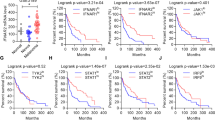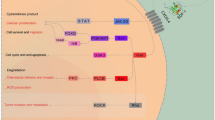Abstract
We previously demonstrated that mesenchymal stem/stromal cells (MSC) are recruited to tumors and that IFN-β produced by MSC inhibited tumor growth in xenograft models. Because of a deficient immune system, murine xenograft models cannot fully recapitulate tumor and immune cell interactions during progression. Therefore we investigated the capacity of MSC to migrate to and engraft into primary breast tumor sites and subsequently explore mechanisms of tumor inhibition by MSC-delivered IFN-β in a syngeneic, immunocompetent murine model. Herein we report that 1) systemically administrated MSC migrate to established 4 T1 breast cancer sites and localize among the tumor-stroma border and throughout the tumor mass; 2) high levels of IFN-β secreted by MSC are detectable in the tumor microenvironment but not in circulation; 3) intratumorally produced IFN-β inactivates constitutive phosphorylation of signal transducer activator transcription factor 3 (Stat3), Src, and Akt and down-regulates cMyc and MMP2 expression in 4 T1 cells, and 4) in mice with established breast cancer IFN-β expressing MSC administered systemically resulted in inhibition of primary cancer growth and in dramatic reduction of pulmonary and hepatic metastases. 5) MSC-IFN-β treated, but not control mice, maintained normal levels of splenic mature dendritic (DC), CD8+ T cells and CD4+/Foxp3+ regulatory T-cells (Treg). Our findings suggest that MSC are capable of migrating to tumor sites in an immunocompetent environment, that IFN-β produced by MSC suppresses breast cancer growth through inhibition of Stat3 signaling, and dramatically reduces pulmonary and hepatic metastases.







Similar content being viewed by others
References
Oreffo RO, Cooper C, Mason C, Clements M (2005) Mesenchymal stem cells: lineage, plasticity, and skeletal therapeutic potential. Stem Cell Rev 1(2):169–178
Prockop DJ (1997) Marrow stromal cells as stem cells for nonhematopoietic tissues. Science 276(5309):71–74
Hall B, Andreeff M, Marini F (2007) The participation of mesenchymal stem cells in tumor stroma formation and their application as targeted-gene delivery vehicles. Handb Exp Pharmacol 180:263–283
Nakamizo A, Marini F, Amano T, Khan A, Studeny M, Gumin J et al (2005) Human bone marrow-derived mesenchymal stem cells in the treatment of gliomas3. Cancer Res 65(8):3307–3318
Studeny M, Marini FC, Champlin RE, Zompetta C, Fidler IJ, Andreeff M (2002) Bone marrow-derived mesenchymal stem cells as vehicles for interferon-beta delivery into tumors1. Cancer Res 62(13):3603–3608
Ponte AL, Marais E, Gallay N, Langonne A, Delorme B, Herault O et al (2007) The in vitro migration capacity of human bone marrow mesenchymal stem cells: comparison of chemokine and growth factor chemotactic activities. Stem Cells 25(7):1737–1745
Studeny M, Marini FC, Dembinski JL, Zompetta C, Cabreira-Hansen M, Bekele BN et al (2004) Mesenchymal stem cells: potential precursors for tumor stroma and targeted-delivery vehicles for anticancer agents. J Natl Cancer Inst 96(21):1593–1603
Birnbaum T, Roider J, Schankin CJ, Padovan CS, Schichor C, Goldbrunner R et al (2007) Malignant gliomas actively recruit bone marrow stromal cells by secreting angiogenic cytokines. J Neurooncol 83(3):241–247
Yoshida J, Mizuno M, Wakabayashi T (2004) Interferon-beta gene therapy for cancer: basic research to clinical application. Cancer Sci 95(11):858–865
Bianchini F, Mannini A, Mugnai G, Ruggieri S, Calorini L (2006) Expression of a metastatic phenotype in IFNs-primed/TNFalpha-activated B16 murine melanoma cells: role of JAK1/PKCdelta signal transduction factors. Clin Exp Metastasis 23(3–4):203–208
Sharief MK, Semra YK (2002) Down-regulation of survivin expression in T lymphocytes after interferon beta-1a treatment in patients with multiple sclerosis. Arch Neurol 59(7):1115–1121
Yoshiji H, Kuriyama S, Noguchi R, Yoshii J, Ikenaka Y, Yanase K et al (2005) Combination of interferon-beta and angiotensin-converting enzyme inhibitor, perindopril, attenuates the murine liver fibrosis development. Liver Int 25(1):153–161
Genka S, Shitara N, Tsujita Y, Kosugi Y, Takakura K (1988) Effect of interferon-beta on the cell cycle of human glioma cell line U-251 MG: flow cytometric two-dimensional (BrdU/DNA) analysis. J Neurooncol 6(4):299–307
Takeda K, Noguchi K, Shi W, Tanaka T, Matsumoto M, Yoshida N et al (1997) Targeted disruption of the mouse Stat3 gene leads to early embryonic lethality. Proc Natl Acad Sci U S A 94(8):3801–3804
Bowman T, Garcia R, Turkson J, Jove R (2000) STATs in oncogenesis. Oncogene 19(21):2474–2488
Clevenger CV (2004) Roles and regulation of stat family transcription factors in human breast cancer. Am J Pathol 165(5):1449–1460
Darnell JE Jr (1997) STATs and gene regulation. Science 277(5332):1630–1635
Garcia R, Yu CL, Hudnall A, Catlett R, Nelson KL, Smithgall T et al (1997) Constitutive activation of Stat3 in fibroblasts transformed by diverse oncoproteins and in breast carcinoma cells. Cell Growth Differ 8(12):1267–1276
Ling X, Arlinghaus RB (2005) Knockdown of STAT3 expression by RNA interference inhibits the induction of breast tumors in immunocompetent mice. Cancer Res 65(7):2532–2536
Ling X, Konopleva M, Zeng Z, Ruvolo V, Stephens LC, Schober W et al (2007) The novel triterpenoid C-28 methyl ester of 2-cyano-3, 12-dioxoolen-1, 9-dien-28-oic acid inhibits metastatic murine breast tumor growth through inactivation of STAT3 signaling. Cancer Res 67(9):4210–4218
Gabrilovich D (2004) Mechanisms and functional significance of tumour-induced dendritic-cell defects. Nat Rev Immunol 4(12):941–952
Gervais A, Leveque J, Bouet-Toussaint F, Burtin F, Lesimple T, Sulpice L et al (2005) Dendritic cells are defective in breast cancer patients: a potential role for polyamine in this immunodeficiency. Breast Cancer Res 7(3):R326–R335
Nefedova Y, Gabrilovich DI (2007) Targeting of Jak/STAT pathway in antigen presenting cells in cancer. Curr Cancer Drug Targets 7(1):71–77
Rabinovich GA, Gabrilovich D, Sotomayor EM (2007) Immunosuppressive strategies that are mediated by tumor cells. Annu Rev Immunol 25:267–296
Yu H, Kortylewski M, Pardoll D (2007) Crosstalk between cancer and immune cells: role of STAT3 in the tumour microenvironment. Nat Rev Immunol 7(1):41–51
Yang L, Carbone DP (2004) Tumor-host immune interactions and dendritic cell dysfunction. Adv Cancer Res 92:13–27
Elpek KG, Lacelle C, Singh NP, Yolcu ES, Shirwan H (2007) CD4 + CD25+ T regulatory cells dominate multiple immune evasion mechanisms in early but not late phases of tumor development in a B cell lymphoma model. J Immunol 178(11):6840–6848
Filaci G, Fenoglio D, Fravega M, Ansaldo G, Borgonovo G, Traverso P et al (2007) CD8+CD28-T Regulatory Lymphocytes Inhibiting T Cell Proliferative and Cytotoxic Functions Infiltrate Human Cancers. J Immunol 179(7):4323–4334
Schabowsky RH, Madireddi S, Sharma R, Yolcu ES, Shirwan H (2007) Targeting CD4 + CD25 + FoxP3+ regulatory T-cells for the augmentation of cancer immunotherapy. Curr Opin Investig Drugs 8(12):1002–1008
Wang HY, Wang RF (2007) Regulatory T cells and cancer. Curr Opin Immunol 19(2):217–223
Carpentier AF, Meng Y (2006) Recent advances in immunotherapy for human glioma. Curr Opin Oncol 18(6):631–636
Lizee G, Radvanyi LG, Overwijk WW, Hwu P (2006) Improving antitumor immune responses by circumventing immunoregulatory cells and mechanisms. Clin Cancer Res 12(16):4794–4803
Pallandre JR, Brillard E, Crehange G, Radlovic A, Remy-Martin JP, Saas P et al (2007) Role of STAT3 in CD4 + CD25 + FOXP3+ regulatory lymphocyte generation: implications in graft-versus-host disease and antitumor immunity. J Immunol 179(11):7593–7604
Aslakson CJ, Miller FR (1992) Selective events in the metastatic process defined by analysis of the sequential dissemination of subpopulations of a mouse mammary tumor. Cancer Res 52(6):1399–1405
Ling X, Ma G, Sun T, Liu J, Arlinghaus RB (2003) Bcr and Abl interaction: oncogenic activation of c-Abl by sequestering Bcr. Cancer Res 63(2):298–303
Burke WM, Jin X, Lin HJ, Huang M, Liu R, Reynolds RK et al (2001) Inhibition of constitutively active Stat3 suppresses growth of human ovarian and breast cancer cells1. Oncogene 20(55):7925–7934
Nam S, Buettner R, Turkson J, Kim D, Cheng JQ, Muehlbeyer S et al (2005) Indirubin derivatives inhibit Stat3 signaling and induce apoptosis in human cancer cells1. Proc Natl Acad Sci U S A 102(17):5998–6003
Nussenzweig MC, Steinman RM, Witmer MD, Gutchinov B (1982) A monoclonal antibody specific for mouse dendritic cells. Proc Natl Acad Sci U S A 79(1):161–165
Parekkadan B (2007) van PD, Megeed Z, Kobayashi N, Tilles AW, Berthiaume F, et al. Immunomodulation of activated hepatic stellate cells by mesenchymal stem cells Biochem Biophys Res Commun 363(2):247–252
Dvorak HF (1986) Tumors: wounds that do not heal. Similarities between tumor stroma generation and woundhealing. N Engl J Med 315(26):1650–1659
Karnoub AE, Dash AB, Vo AP, Sullivan A, Brooks MW, Bell GW et al (2007) Mesenchymal stem cells within tumour stroma promote breast cancer metastasis. Nature 449(7162):557–563
Nakanishi H, Mizutani Y, Kawauchi A, Ukimura O, Shiraishi T, Hatano M et al (2003) Significant antitumoral activity of cationic multilamellar liposomes containing human IFN-beta gene against human renal cell carcinoma. Clin Cancer Res 9(3):1129–1135
Goldstein D, Sielaff KM, Storer BE, Brown RR, Datta SP, Witt PL et al (1989) Human biologic response modification by interferon in the absence of measurable serum concentrations: a comparative trial of subcutaneous and intravenous interferon-beta serine. J Natl Cancer Inst 81(14):1061–1068
Kroger A, Koster M, Schroeder K, Hauser H, Mueller PP (2002) Activities of IRF-1. J Interferon Cytokine Res 22(1):5–14
Pfitzner E, Kliem S, Baus D, Litterst CM (2004) The role of STATs in inflammation and inflammatory diseases. Curr Pharm Des 10(23):2839–2850
Shachaf CM, Kopelman AM, Arvanitis C, Karlsson A, Beer S, Mandl S et al (2004) MYC inactivation uncovers pluripotent differentiation and tumour dormancy in hepatocellular cancer. Nature 431(7012):1112–1117
Mendes O, Kim HT, Lungu G, Stoica G (2007) MMP2 role in breast cancer brain metastasis development and its regulation by TIMP2 and ERK1/2. Clin Exp Metastasis 24(5):341–351
Herber DL, Nagaraj S, Djeu JY, Gabrilovich DI (2007) Mechanism and therapeutic reversal of immune suppression in cancer. Cancer Res 67(11):5067–5069
Gigli G, Caielli S, Cutuli D, Falcone M (2007) Innate immunity modulates autoimmunity: type 1 interferon-beta treatment in multiple sclerosis promotes growth and function of regulatory invariant natural killer T cells through dendritic cell maturation. Immunology 122(3):409–417
Robbins SH, Bessou G, Cornillon A, Zucchini N, Rupp B, Ruzsics Z et al (2007) Natural killer cells promote early CD8 T cell responses against cytomegalovirus. PLoS Pathog 3(8):e123
Carraway KL III, Sweeney C (2006) Co-opted integrin signaling in ErbB2-induced mammary tumor progression. Cancer Cell 10(2):93–95
Spaeth EL, Dembinski JL, Sasser AK, Watson K, Klopp A, Hall B, Andreeff M, Marini F (2009) Mesenchymal stem cell transition to tumor-associated fibroblasts contributes to fibrovascular network expansion and tumor progression. PLoS One 4(4):e4992
Author information
Authors and Affiliations
Corresponding author
Additional information
Supported in part by grants from the National Cancer Institute (CA-55164, CA-16672, CA-49639,P30 and CA016672) and the Paul and Mary Haas Chair in Genetics (to MA). XL is supported in part by P50 CA116199. FM is supported in part by RC1CA146381, CA-109451 and CA-116199 and a grant from the Susan G Komen Breast Cancer Foundation (BCTR0504372).
Electronic supplementary material
Below is the link to the electronic supplementary material.
Supplemental Fig. 1
(GIF 5 kb)
Supplemental Fig. 2-3
(GIF 48 kb)
Supplemental Fig. 4
(GIF 11 kb)
Supplemental Fig. 5
(GIF 10 kb)
Rights and permissions
About this article
Cite this article
Ling, X., Marini, F., Konopleva, M. et al. Mesenchymal Stem Cells Overexpressing IFN-β Inhibit Breast Cancer Growth and Metastases through Stat3 Signaling in a Syngeneic Tumor Model. Cancer Microenvironment 3, 83–95 (2010). https://doi.org/10.1007/s12307-010-0041-8
Received:
Accepted:
Published:
Issue Date:
DOI: https://doi.org/10.1007/s12307-010-0041-8




